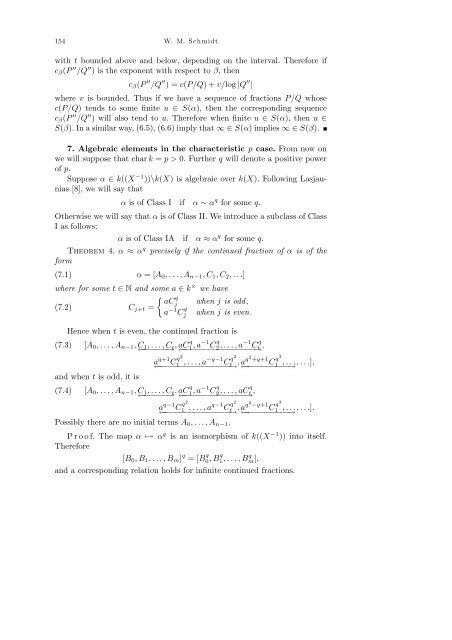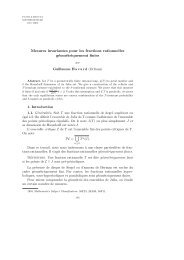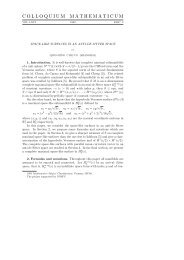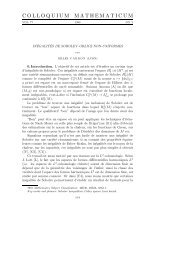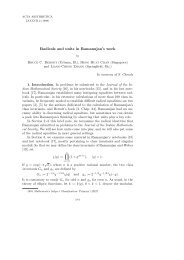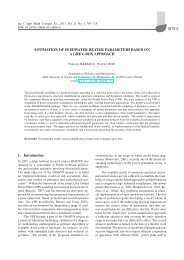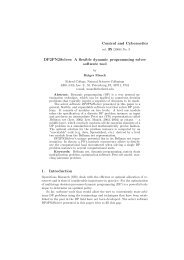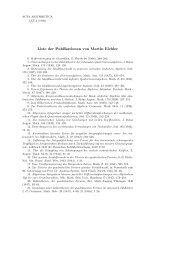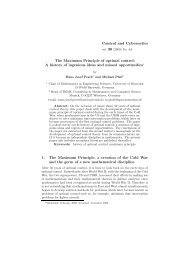On continued fractions and diophantine approximation in power ...
On continued fractions and diophantine approximation in power ...
On continued fractions and diophantine approximation in power ...
You also want an ePaper? Increase the reach of your titles
YUMPU automatically turns print PDFs into web optimized ePapers that Google loves.
154 W. M. Schmidt<br />
with t bounded above <strong>and</strong> below, depend<strong>in</strong>g on the <strong>in</strong>terval. Therefore if<br />
cβ(P ′′ /Q ′′ ) is the exponent with respect to β, then<br />
cβ(P ′′ /Q ′′ ) = c(P/Q) + v/log |Q ′′ |<br />
where v is bounded. Thus if we have a sequence of <strong>fractions</strong> P/Q whose<br />
c(P/Q) tends to some f<strong>in</strong>ite u ∈ S(α), then the correspond<strong>in</strong>g sequence<br />
cβ(P ′′ /Q ′′ ) will also tend to u. Therefore when f<strong>in</strong>ite u ∈ S(α), then u ∈<br />
S(β). In a similar way, (6.5), (6.6) imply that ∞ ∈ S(α) implies ∞ ∈ S(β).<br />
7. Algebraic elements <strong>in</strong> the characteristic p case. From now on<br />
we will suppose that char k = p > 0. Further q will denote a positive <strong>power</strong><br />
of p.<br />
Suppose α ∈ k((X −1 ))\k(X) is algebraic over k(X). Follow<strong>in</strong>g Lasjaunias<br />
[8], we will say that<br />
α is of Class I if α ∼ α q for some q.<br />
Otherwise we will say that α is of Class II. We <strong>in</strong>troduce a subclass of Class<br />
I as follows:<br />
α is of Class IA if α ≈ α q for some q.<br />
Theorem 4. α ≈ α q precisely if the <strong>cont<strong>in</strong>ued</strong> fraction of α is of the<br />
form<br />
(7.1) α = [A0, . . . , An−1, C1, C2, . . .]<br />
where for some t ∈ N <strong>and</strong> some a ∈ k × we have<br />
(7.2) Cj+t =<br />
aC q<br />
j<br />
a −1 C q<br />
j<br />
when j is odd,<br />
when j is even.<br />
Hence when t is even, the <strong>cont<strong>in</strong>ued</strong> fraction is<br />
(7.3) [A0, . . . , An−1, C1, . . . , C<br />
←−−−−−−→ t,<br />
aCq 1 , a−1C q<br />
2 , . . . , a−1C q<br />
←−−−−−−−−−−−−−−−−→ t ,<br />
a q+1 C q2<br />
1 , . . . , a−q−1C q2<br />
←−−−−−−−−−−−−−−−−→ t , aq2 +q+1 q<br />
C 3<br />
1 , . . . , . . .],<br />
←−−−−−−−−−−→<br />
<strong>and</strong> when t is odd, it is<br />
(7.4) [A0, . . . , An−1, C1, . . . , C<br />
←−−−−−−→ t,<br />
aCq 1 , a−1C q<br />
2 , . . . , aCq<br />
←−−−−−−−−−−−−−−→ t ,<br />
, . . . , . . .].<br />
←−−−−−−−−−−→<br />
a q−1 C q2<br />
1 , . . . , aq−1C q2<br />
←−−−−−−−−−−−−−−−→ t , aq2 −q+1 q<br />
C 3<br />
1<br />
Possibly there are no <strong>in</strong>itial terms A0, . . . , An−1.<br />
P r o o f. The map α ↦→ αq is an isomorphism of k((X−1 )) <strong>in</strong>to itself.<br />
Therefore<br />
[B0, B1, . . . , Bm] q = [B q<br />
0 , Bq 1 , . . . , Bq m],<br />
<strong>and</strong> a correspond<strong>in</strong>g relation holds for <strong>in</strong>f<strong>in</strong>ite <strong>cont<strong>in</strong>ued</strong> <strong>fractions</strong>.


